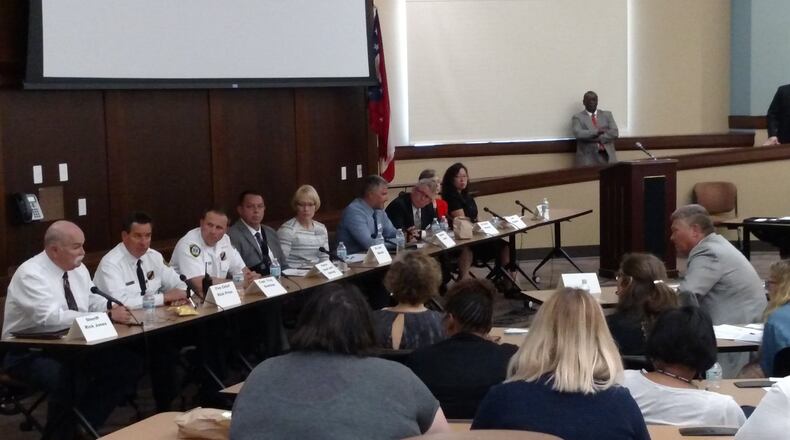“Just don’t think that this is just in the inner cities,” Butler County Sheriff Richard Jones said Friday during a forum about heroin in West Chester Twp. “This has shifted out into the county. It is out everywhere.”
More than 40 percent of the 453 cases handled by the Butler County Coroner’s Office last year were overdose related, and 80 percent of last year’s 192 overdoses were heroin/fentanyl-related overdose deaths, according to Butler County Coroner Dr. Lisa Mannix.
In 2015, firefighters, paramedics and other first responders administered naloxone 19,782 times in Ohio.
Jones is not a fan of naloxone, or Narcan, being used to help revive addicts, he said, because deputies are not armed with it. Nor is he a supporter of any levy that puts money toward prevention programs.
“I don’t know I would support a levy to support programs because we are all strapped for money,” Jones said.
Officials in Middletown, the Butler County community that saw the highest number of deaths from heroin cut with fentanyl (52) last year, estimates as much as 90 percent of public safety services are connected to fighting the drug.
That commitment takes away from police officers and firefighters completing other responsibilities, Middletown City Manager Doug Adkins told the Journal-News in March.
“It’s eating our public safety services alive,” he said in the spring during the city’s ninth heroin summit.
Dr. Elizabeth LeeNellett, medical director at the West Chester Hospital Emergency Department, said it is frustrating trying to figure out how to help Narcan-treated patients.
“When you bring these patients back, they are not happy because you have ruined their high,” she said during Friday’s forum. “They are not looking for help and they don’t want to be given information about rehab. When you tell them that they’ve just about died and you’ve brought them back, they don’t care. It’s frustrating because a few hours later you will see them again.”
Mannix said buying heroin now is like playing Russian roulette because chances are it is actually fentanyl and not heroin at all.
“We identify it as heroin because that’s the perception of it. But what’s killing people today in Butler County is fentanyl,” she said.” It is a synthetic and is not the poppies grown in Afghanistan. This is not your grandfather’s heroin.”
Many people turn to heroin when their addiction to opiates becomes too expensive or their supply runs out.
“Unfortunately the coroner’s office is the last stop on a bad journey for these people addicted to opiates,” Mannix said.
Jones said he believes more must be done to reach children earlier about the dangers of drug.
“The governor has a committee, the attorney general has a committee, everybody has committee. We all get together and talk about the same things and nothing gets done,” he said.
But Lori Higgins, president, Envision Partnerships, said the forum and all information leading to fighting the drug problem is positive and not a waste of time.
“We absolutely need to keep working on this issue,” she told the Journal-News after the meeting. “We are making strides and making an impact. People should not forget that alcohol is a huge problem with younger youth and so is marijuana. There is an acceptance with marijuana in our country.”
Friday’s program was sponsored by the Caring Community Collaborative (C3), a local non-profit organization working to improve the quality of life in the area.
About the Author
